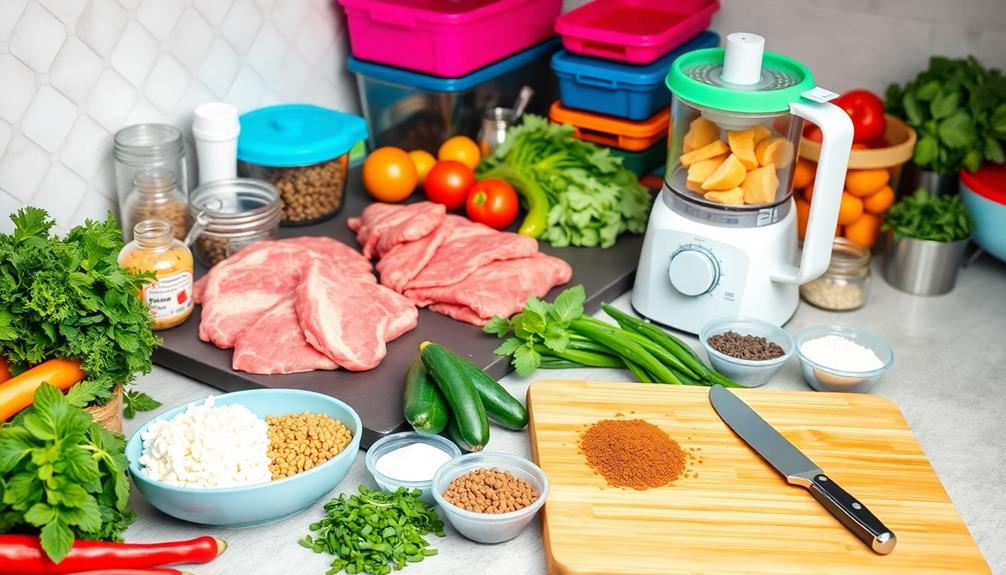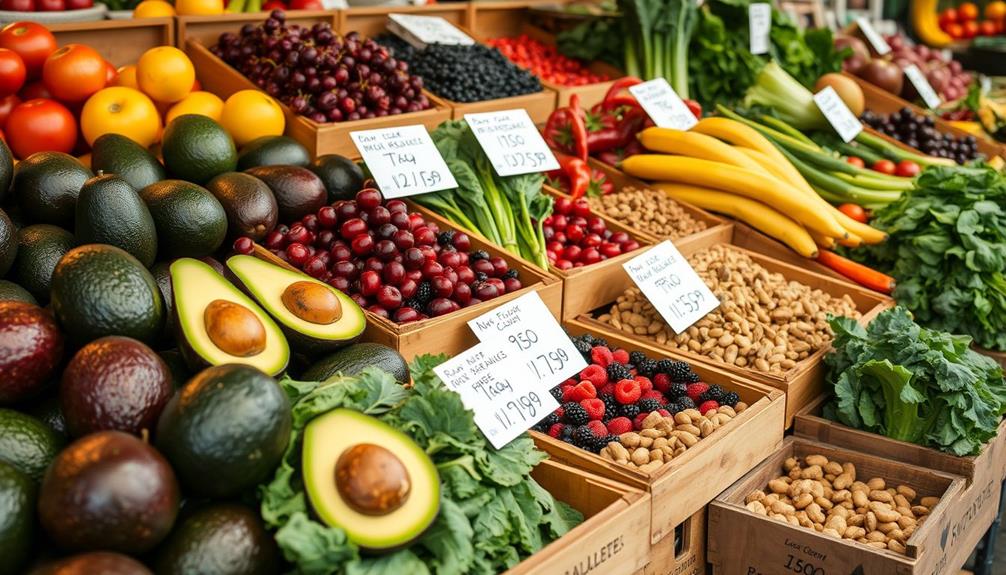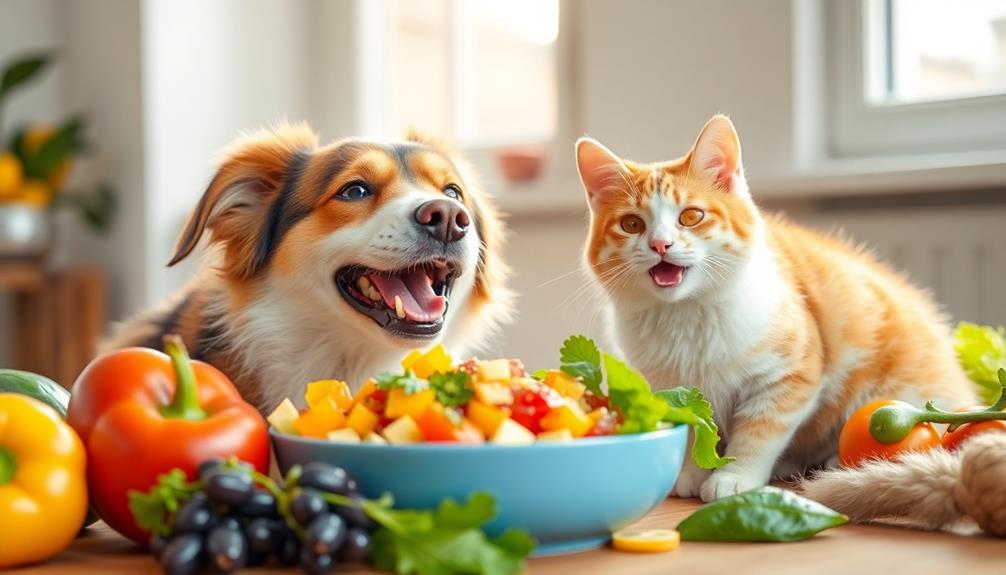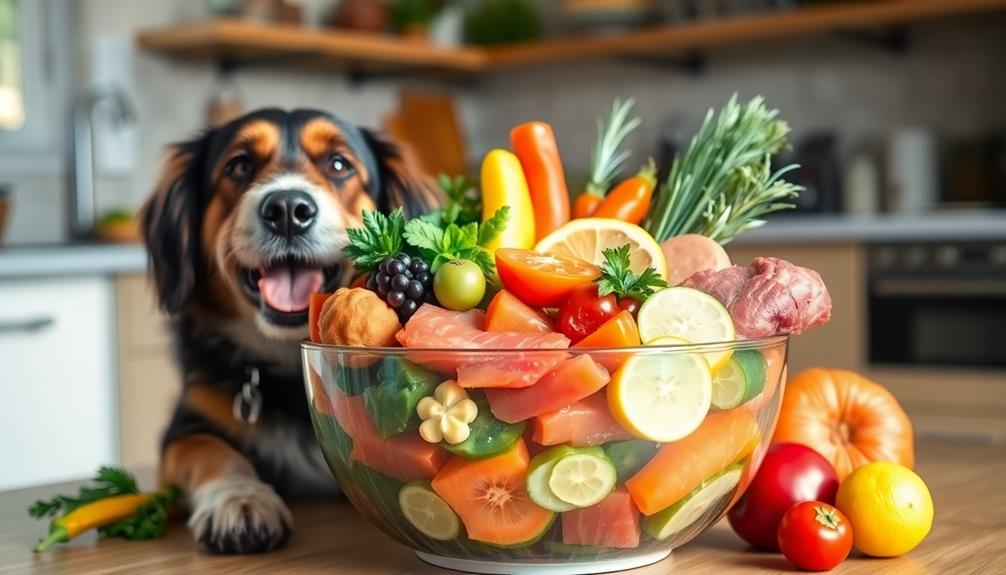Batch preparing raw pet food can make your life easier and save you time. Start by calculating accurate feeding amounts based on your pet's weight and activity level. Pre-portion meals into designated containers to simplify daily feeding and prevent waste. Choose 2-3 simple recipes for each week to keep things organized and varied. Implement proper thawing techniques, like using the refrigerator, to guarantee food safety. Finally, consider joining a co-op for bulk buying discounts. With these tips, you can streamline your pet food prep while guaranteeing your furry friend stays healthy and happy. There's so much more you can explore!
Key Takeaways
- Pre-portion meals into containers to streamline daily feeding and minimize waste, ensuring accurate serving sizes for your pet's needs.
- Use a digital kitchen scale for precise ingredient measurements to maintain proper nutritional balance and avoid overfeeding.
- Thaw raw food safely in the refrigerator or using the cold water method to prevent bacterial growth and ensure freshness.
- Select 2-3 simple recipes weekly and rotate them to provide balanced nutrition while reducing meal prep overwhelm.
- Join local co-ops or buying groups to lower costs on bulk purchases, making batch preparing more budget-friendly.
Calculate Feeding Amounts
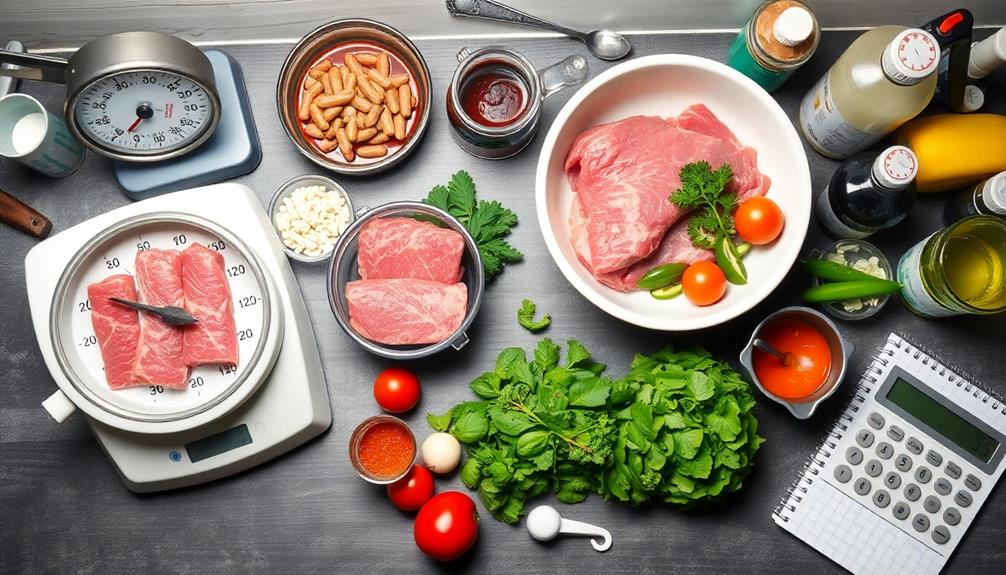
Calculating feeding amounts for your pet is vital for their health and well-being. To determine how much food your dog needs, assess their ideal body weight, activity level, and age. For daily feeding, a general rule is around 18-20 ounces (510-567 grams) of food for every 1,000 calories.
Once you've calculated the daily amount, multiply it by 7 to get the total amount needed for the week. This step helps streamline your bulk meal prep process.
For monthly estimates, simply multiply your weekly totals by 4 or 30, which aids in budgeting for raw ingredients. Remember, puppies and kittens require different maintenance percentages due to their growth needs, so adjust accordingly.
Ingredient ratios are also vital when crafting a balanced raw diet. If you're using a PMR diet, aim for an 80/10/5/5 ratio, while a BARF diet typically follows a 70/10/5/5/10 ratio.
Understanding these ratios will help you calculate how much of each ingredient you need to prepare meals that meet your pet's nutritional requirements. Proper calculations guarantee your furry friend stays healthy and happy!
Plan Recipes and Rotation
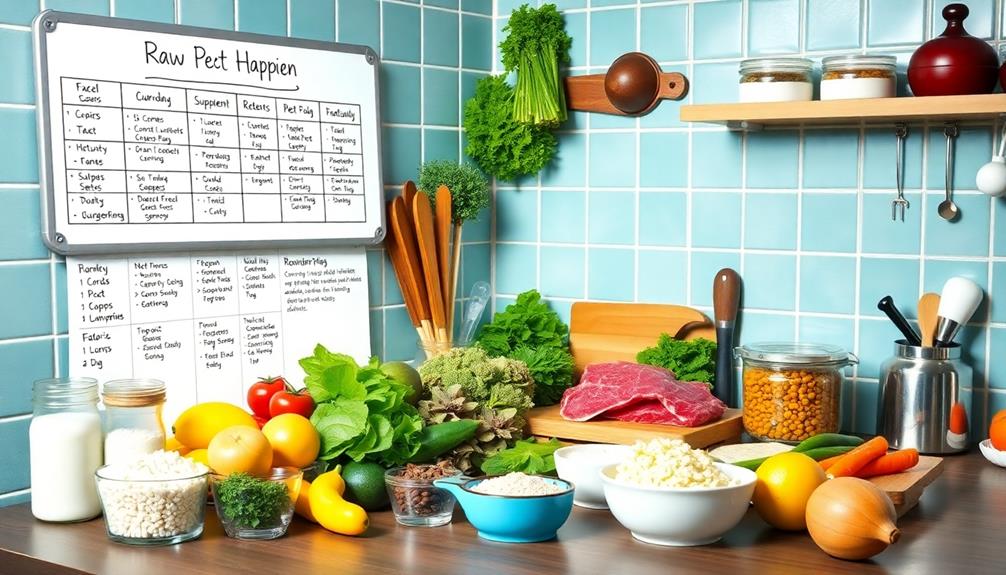
When planning your pet's meals, selecting a variety of recipes is key to maintaining their interest and nutrition.
Establishing a meal rotation not only simplifies your preparation process but also helps you manage your inventory effectively.
Recipe Selection Strategies
To create a balanced and enjoyable diet for your pet, start by selecting 2-3 simple recipes for the week. This approach reduces overwhelm and allows you to focus on feeding your dog a complete raw diet.
Aim for 3-4 repetitions of each recipe to streamline your meal prep.
As you grow more comfortable, gradually increase the complexity and variety of your recipes. This strategy guarantees a balanced diet filled with diverse nutrients.
Implement a meal rotation system to introduce various protein sources, which helps prevent nutritional deficiencies and keeps mealtime interesting for your pet.
Always keep ingredient availability in mind. Stay aware of seasonal changes and adjust your recipes accordingly to maintain freshness.
Planning recipes that align with your pet's specific dietary needs—like age, activity level, and food sensitivities—will enhance their overall health.
Meal Rotation Benefits
Implementing a meal rotation system not only simplifies your meal prep but also enriches your pet's diet greatly. By rotating meals, you can effectively prevent nutritional deficiencies, guaranteeing your furry friend receives a balanced intake of essential nutrients.
Incorporating a variety of protein sources, like:
- Tender chicken chunks
- Savory beef morsels
- Flaky fish pieces
- Nutritious vegetable blends
This diverse range of ingredients keeps mealtime exciting and helps meet your pet's dietary needs. Additionally, proper diet guidelines suggest including fresh fruits and vegetables for added health benefits.
Planning just a few recipes per week allows for 3-4 repetitions, reducing the overwhelm often felt during meal prep.
Moreover, rotating meals every month can markedly enhance your pet's eating experience, promoting better food acceptance. They won't get bored with their meals, and you can feel confident knowing they're getting a balanced diet.
A well-structured meal rotation not only saves time but guarantees that your pet enjoys a variety of flavors and textures while receiving the essential nutrients they need. Embrace meal rotation, and watch as your pet thrives on a well-rounded diet!
Meal Prep Methodology
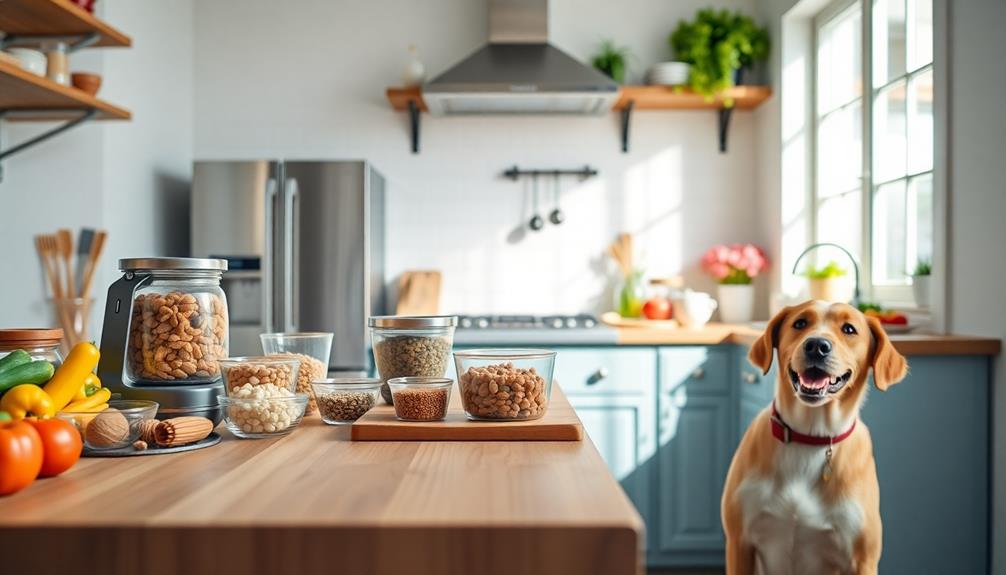
Meal prep methodology is vital for efficiently managing your raw pet food supplies. Start by determining the percentage of your dog's body weight to feed and calculate the total raw food needed based on how many days you plan to prepare meals ahead of time.
Before placing a bulk order for raw meat, assess your current inventory of meat, bones, and organs to avoid overstocking or understocking. Designate a specific day for picking up bulk raw meat; this keeps your meal prep organized and guarantees that all ingredients are ready for processing.
Once you have your ingredients, use 64 oz plastic containers to store your meals. This helps you portion out your complete and balanced raw recipes appropriately, making it easy to grab and serve when it's time to feed your dog.
Regularly reviewing and updating your meal prep methodology is essential, too. Incorporate seasonal ingredients to provide variety in your pet's diet.
With a solid meal prep methodology in place, you'll streamline the process, ensuring your furry friends enjoy nutritious meals every day!
Daily Meal Assembly
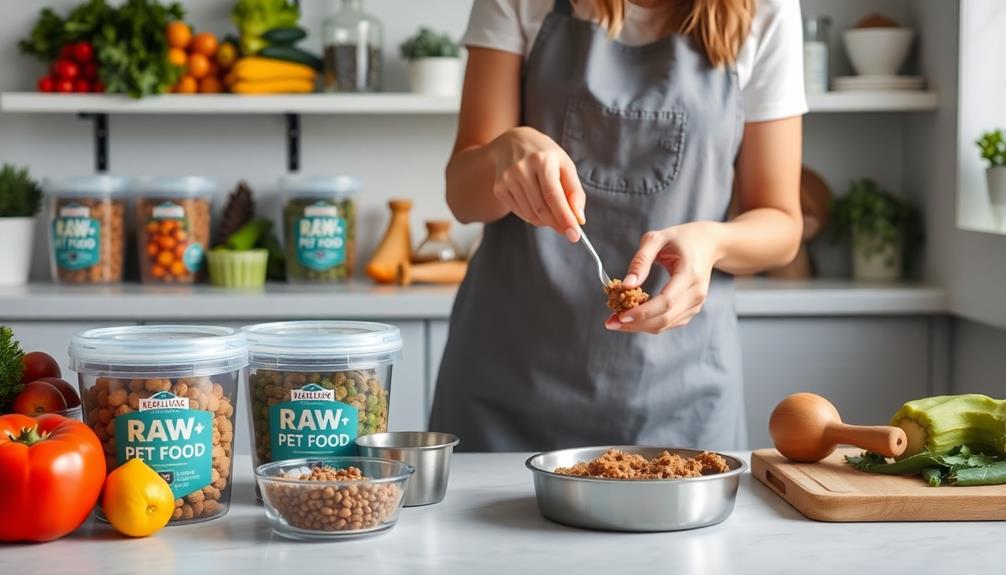
When it comes to daily meal assembly, proper thawing techniques are key to keeping your pet's food safe and fresh.
You'll want to plan your portions accurately each day, ensuring your furry friend gets the right amount without waste.
Sticking to a routine not only helps with consistency but also makes the process smoother for your busy schedule.
Ingredient Thawing Techniques
Thawing raw pet food ingredients properly is vital for guaranteeing your pet's safety and health. By following the right thawing techniques, you can effectively prevent bacterial growth and prepare for your weekly meals. Here are some useful methods:
- Thaw in the refrigerator: Let ingredients sit for 24 hours for safe and gradual thawing.
- Thaw in cold water: Submerge sealed bags in cold water, changing the water every 30 minutes for quicker thawing.
- Avoid room temperature: Never thaw raw ingredients at room temperature, as this can lead to harmful bacteria multiplying on the food.
- Microwave with caution: Only use a microwave for thawing if you'll use the ingredients immediately, as uneven heating can create hot spots.
Planning your thawing schedule is essential.
Always aim to use the oldest items first, minimizing waste while keeping your pet's meals fresh and safe.
Daily Portion Accuracy**
Accurate daily portions are fundamental for keeping your pet at a healthy weight and meeting their nutritional needs. By measuring their food precisely, you guarantee each meal provides the right daily calorie intake. Using a digital kitchen scale can help you weigh each ingredient accurately, which keeps portion sizes consistent and reduces the risk of overfeeding or underfeeding.
Pre-portioning meals into individual containers streamlines your daily assembly process. It allows you to grab and serve the right amount without extra measuring, making mealtime easier for both you and your pet.
Additionally, maintaining a feeding log is a great way to track your pet's daily intake. This log helps you make adjustments based on their activity level and any changes in their weight or health.
Regularly recalibrating your portion sizes is essential, especially as your pet grows or their activity level changes. This guarantees their nutritional needs are consistently met, promoting ideal health and well-being.
Pros and Cons of Methods
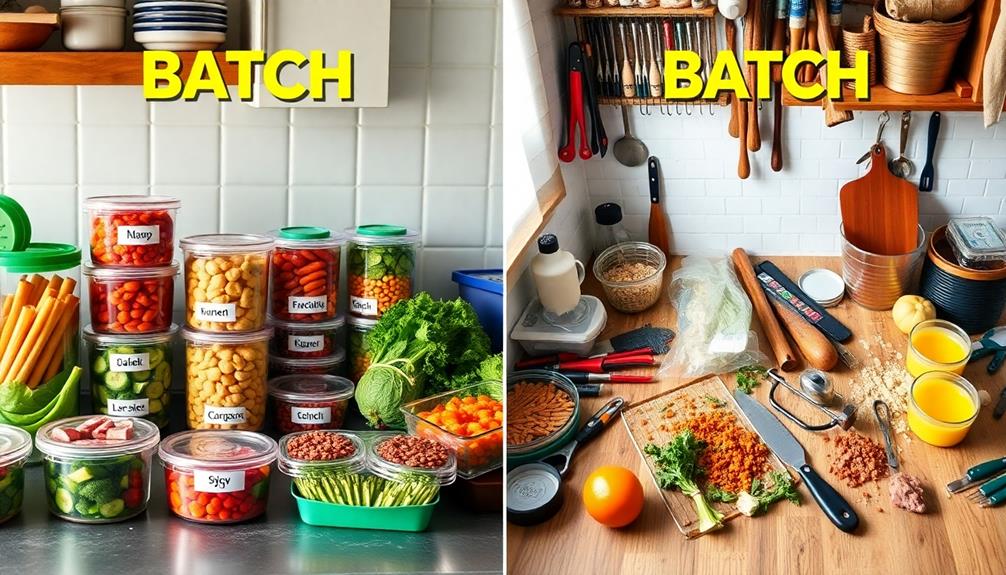
Batch preparing raw pet food offers a mix of advantages and challenges that every pet owner should consider. This method can drastically improve meal quality and save you time during the week, giving you more time to spend with your furry friend.
- Consistent, ready-to-serve meals waiting in your freezer
- Lower prices per pound through bulk purchasing
- Easy access to nutritious meals with proper freezing portions
- A one-time initial time investment for long-term convenience
On the upside, batch preparing allows you to maintain the nutritional integrity of your pet's food while ensuring you have a stockpile of meals ready.
However, you'll need adequate freezer space, which can be a limitation if you have a smaller freezer. Additionally, the initial time investment can feel overwhelming, especially for busy pet parents.
Yet, the long-term benefits of convenience often outweigh this initial hurdle. By planning ahead, you can create a steady supply of raw pet food that meets your pet's dietary needs and fits your schedule, ultimately leading to a healthier and happier pet.
Budgeting for Raw Feeding
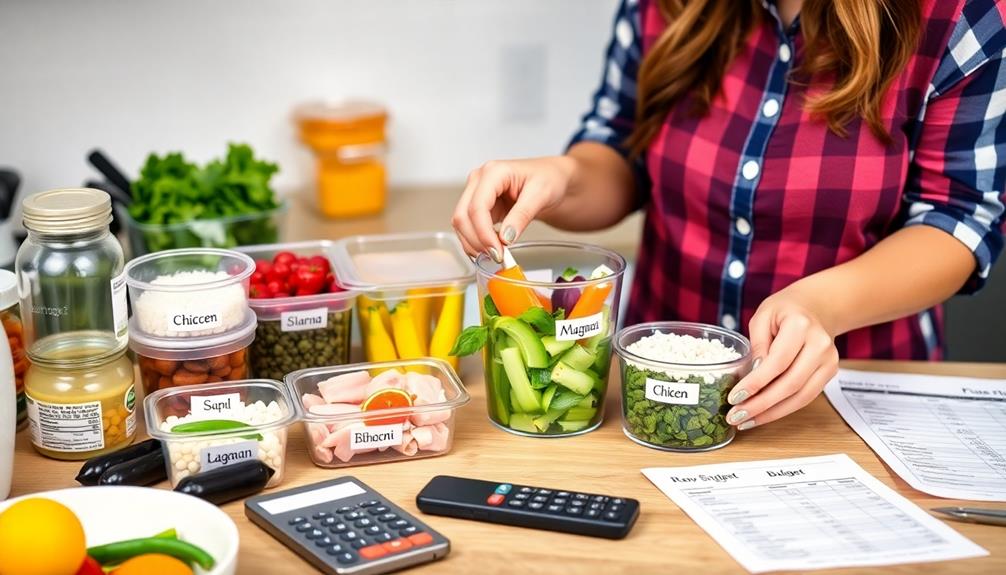
Budgeting for raw feeding is essential for pet owners who want to provide a nutritious diet without breaking the bank. The average cost for a complete raw diet is around $2.50 per pound, making careful budgeting vital to manage your expenses effectively.
To keep costs down, consider price shopping for bulk purchases, which can drop your cost below $2.00 per pound. Incorporating natural therapies like aromatherapy for emotional support can also enhance your pet's well-being while you focus on budgeting.
Joining local co-ops or buying groups is another smart move; these options often provide discounted rates and a variety of protein sources, further reducing your overall costs.
Monthly estimates based on your dog's weight and dietary needs can help you budget accurately, ensuring you plan your purchases to avoid unexpected expenses.
Regularly assess and adjust your budget according to seasonal ingredient availability and local resources. This practice not only optimizes your expenditure but also helps you maintain a balanced diet for your pet.
Common Pitfalls to Avoid

Often, pet owners overlook common pitfalls when preparing raw meals for their furry friends. Guaranteeing your dog's diet includes high-quality protein sources, similar to those found in best dog food for allergies, can support their overall health and well-being.
Avoiding these mistakes can guarantee your dogs thrive on a balanced diet and prevent health issues down the line. Here are some key pitfalls to dodge:
- Incomplete meals: Always include necessary protein, organ, and vegetable components to provide complete nutrition.
- Overfeeding: Carefully calculate portion sizes based on your dog's weight and activity level to maintain a healthy body condition.
- Neglecting hygiene: Use separate utensils and cutting boards for raw ingredients, and always clean surfaces thoroughly to prevent foodborne illnesses.
- Ignoring calcium and phosphorus levels: Monitor these closely, especially in growing puppies, to avoid serious health issues. Consult your vet for specific ratios.
Additionally, keep an eye on your dog's stool consistency. Abnormal stools can indicate digestive issues or dietary imbalances, signaling the need for adjustments in their food.
Frequently Asked Questions
How to Make Raw Dog Food in Bulk?
To make raw dog food in bulk, calculate your dog's dietary needs, purchase quality ingredients in bulk, prepare meals on a designated day, portion them into containers, and store properly to maintain freshness and safety.
How to Bulk up Raw Dog Food?
To bulk up raw dog food, you can add healthy fillers like vegetables, grains, or legumes. Mix in nutrient-dense ingredients to enhance the nutritional profile while ensuring your dog's meals remain balanced and satisfying.
How Can I Make Raw Dog Food Last Longer?
To make raw dog food last longer, you're gonna want to store it like it's the last gourmet meal on Earth! Use airtight containers, freeze portions, and label them to keep everything fresh and safe.
What Is the 80 10 5 5 Raw Diet?
The 80/10/5/5 raw diet consists of 80% lean muscle meat, 10% raw bone, 5% liver, and 5% other organs. This balanced mix promotes your dog's health, supporting digestion, dental health, and nutrient intake.
Conclusion
With a little planning and creativity, you can turn raw pet food prep into a seamless dance rather than a chaotic scramble. By calculating feeding amounts, rotating recipes, and streamlining your daily assembly, you'll save time while nourishing your furry friend. Just remember to avoid common pitfalls and keep an eye on your budget. With these tips, you'll be well on your way to a healthy, happy pet, and a more efficient kitchen rhythm.

